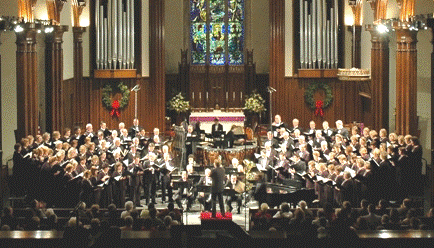Thursday night’s concert brought an orchestra comprised of Eastern Music Festival students, mostly from the US but also from Germany, Taiwan, India, Hong Kong, Canada, France, China, Jamaica, Australia, Argentina, Peru, Italy, Bolivia, South Korea, the UK, and Portugal. They come to Greensboro for the five-week festival – to take lessons, to participate in masterclasses, and to perform. And they really can perform!
Samuel Jones (b.1935) is a distinguished American educator, conductor, and composer who has had a long friendship with EMF music director Gerard Schwarz, for whom he worked as composer-in-residence with the Seattle Symphony Orchestra from 1997 to 2011. His Flute Concerto (2018) was written for a commission by flutist Jeffrey Khaner and the Philadelphia Orchestra. The 25-minute composition is in three movements: Lament, Interludio, and Dream Montage: America Marching. The soloist was principal EMF flutist Les Roettges, who is also principal for the Jacksonville Symphony Orchestra. José-Luis Novo, EMF resident conductor, directed the large orchestra without a baton.
Jones says this about the concerto: “I was so moved by the history of the flute. It’s one of the most ancient instruments…” The opening lament, written during a “period of grieving for the recent loss of his brother,” begins with low strings intoning an open fifth, perhaps hearkening back to the beginning of time? The flute enters with a descending melodic line, a gesture that is reiterated several times in the course of the movement. Repeated dramatic outbursts from the orchestra increase the intensity. After a flute cadenza, serene longing returns.
The second movement is lighter, with some perky licks; it certainly is more virtuosic and puts the flutist through his paces, all handled with skillful playing on the part of Roettges.
The final movement “takes us on a journey through American history.” Jones says ” . . I wanted it to be kind of a survey of the people’s music through all those first years of the revolution . . . . into the struggles of the present . . . recognizing . . . that we are still struggling to make this a more perfect union.”
Indeed, several snippets of familiar tunes such as “Johnny Comes Marching Home,” “Battle Hymn of the Republic,” and “We Shall Overcome” are heard. Also present are military drum rolls and other battle elements as well as marching feet. Novo, who often directed with large-scale and dramatic gestures, urged the orchestra to give its all through this complex score. Ensemble throughout was terrific and the musicians rose to the challenge of the contemporary music. Soloist Roettges masterfully played the many emotional states with authority and artistry.
The Planets, by Gustav Holst (England, 1874-1934), was first performed in 1920, although some of the music was written before WWI. The work shot him into the international limelight. It is scored for a huge orchestra including 4 flutes, English horn, 4 clarinets including bass, 4 bassoons including contrabassoon, 6 horns, 4 trumpets, bass trombone, tenor tuba, tuba, 2 harps, celeste, organ, and six percussionists! In other words, Holst had at his disposal instruments from the highest to the lowest. And he uses them all, both for gigantic climaxes, but also for tender, colorful solos. Throughout, Novo (again without a baton) was able bring out both the passion as well as the intimacy and delicacy that is in the score.
Few works have influenced so many composers, including those as disparate as John Williams (Star Wars quotes from “Mars”) and Frank Zappa (the album Absolutely Free, from “Jupiter”). The work is in seven movements and is more about the mystical meanings of the planets than about the science. Hence, Earth is not included, nor is Pluto, which had not yet been discovered.
Set, in 5/4 time, “Mars, the Bringer of War,” is the most famous of the movements. It is distinctly aggressive, with its incessant drumming, powerful low brass, and surging climaxes. “Venus, the Bringer of Peace” is more liquid and calm.
“Mercury, the Winged Messenger” flits along with distinctive celeste and harp sounds. “Jupiter, the Bringer of Jollity” is completely optimistic, with lots of drums and brass and full orchestra. “Saturn, the Bringer of Old Age” is a funeral march, a slow and solemn affair.
“Uranus, the Magician” comes awfully close to quoting Dukas’ Sorceror’s Apprentice in mood and orchestration. The movement is a potpourri of orchestral color. The finale, “Neptune, the Mystic” brings back the harps and celeste for an “other worldly” movement complete with women’s voices.
Through the long work, the orchestra remained focused and served up outstanding music – from full ensemble to the many solos handled with great maturity and beauty by the young performers. I have only one question: where were the singers in the last movement?
The Eastern Music Festival continues throughout July. See our calendar for listings.












